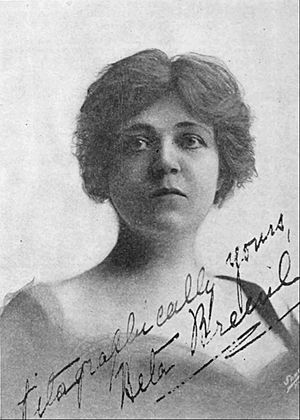Beta Breuil facts for kids
Quick facts for kids
Beta Breuil
|
|
|---|---|

Beta Breuil, photographed 1912. Signed, “Vitagraphically yours.”
|
|
| Born |
Elizabeth Donner Vanderveer
1876 New York City, U.S.
|
| Occupation | Screenwriter |
| Years active | 1911–1918 |
| Spouse(s) | Frank Milne Willard (m.1893, d.1904), Hartmann Breuil (m.1904,d.1908) |
Beta Breuil (born in 1876) was a talented screenwriter and script editor. Her real name was Elizabeth Donner Vanderveer. She helped create many movies in the early 1900s. She wrote stories for films and helped choose which scripts would be made into movies.
Contents
Early Life
Beta Breuil was born in New York City in 1876. Her father, Frank S. Vanderveer, was a lawyer. Her family had enough money for her to go to schools in New York City and also in Germany.
In 1893, Beta married Frank Milne Willard. He owned a successful business. After he passed away in 1904, Beta married Hartmann Breuil in the same year. She later used his last name, Breuil, for her professional work. Hartmann Breuil also passed away four years later. After losing both her husbands, Beta Breuil decided to start a career in the entertainment world.
Her Career in Movies
Beta Breuil was over 30 when she began her professional journey. She first tried acting in plays. Then, she started working for the Vitagraph Company of America. This was a movie studio in Brooklyn.
Working at Vitagraph Studios
In 1910, Beta sent some story ideas to Vitagraph. They hired her as an assistant. She quickly moved up the ranks. In just four months, she became the head of the scenario department. This department was in charge of reading and choosing movie scripts.
Vitagraph was known for its excellent scenario department. Beta Breuil herself explained how they chose scripts. She said they "weeded out" the good ones from the bad. About 75 to 100 scripts arrived every day. Two trained readers would review them. The best ones then went to the editor. The New York Times reported that Vitagraph received up to 500 scripts each week. Beta's department handled all of them. Many people gave Beta credit for making the department so efficient.
After Vitagraph
After leaving Vitagraph, Beta Breuil worked as a freelance writer. This meant she wrote scripts for different companies when they asked her to. In 1914, she became an "artistic advisor" for the North American Film Corporation. This role meant she could use her creativity to come up with new ideas for films.
Between 1915 and 1916, Beta worked on four films with the Eastern Film Company. These films were called Daisies, Wisteria, Violets, and My Lady of the Lilacs. In 1916, she also did special work for Mirror Films, Inc.
It's hard to know exactly how many films she worked on. This is because her name wasn't always listed in the credits. However, in 1918, she was clearly named as a screenwriter for three films: When a Woman Sins, A Daughter of France, and Life or Honor?.
What People Thought of Her
Beta Breuil was well-known and respected in the movie industry. When she took a short break from work, someone wrote about it in Moving Picture World magazine. They said she had worked non-stop for three years. They also said they would "miss Mrs. Breuil."
Some people criticized female scriptwriters at the time. But in 1913, an article listed Beta Breuil as an excellent example. She was mentioned alongside other great writers like Maibelle Heikes Justice and Gene Gauntier. The article said Beta had written "a couple hundred stories for Vitagraph." It also said she was "doing splendidly as a free lance."
The New York Times wrote about Beta's work. They said she was proud that she always produced the kind of story asked for. She saw her job as a "warfare" against her own imagination. She felt she had always won this battle. Even though her time in the industry was not very long, Beta Breuil was seen as one of the top scriptwriters of her era. She was credited with writing "some of the greatest Vitagraph stories."
Helping Others Succeed
Besides her own writing, Beta Breuil also helped start the careers of important people in the entertainment industry. One of these people was Norma Talmadge. Norma became a famous actress. Beta wrote a series of films for Norma called Belinda, the Slavey; Sleuthing; and A Lady and Her Maid.
There's a story about Norma Talmadge. She had a role in another film written by Beta, called In Neighboring Kingdoms. The director wasn't impressed with Norma's acting. But Beta thought Norma was beautiful. She convinced the co-founder of Vitagraph to keep the actress. Beta also helped bring Laurence Trimble and Jean the Vitagraph Dog to the Vitagraph Company.
Filmography
Screenwriter Credits
- In Neighboring Kingdoms (1910)
- Mario’s Swan Song, or the Tragedy of the Little Musician (1910)
- Rose Leaves (1910)
- Auld Lang Syne (1910)
- The Battle Hymn of the Republic, or, in Washington D.C. 1861 (1911)
- The Misses Finch and Their Nephew Billy (1911)
- Her Choice (1912)
- Rock of Ages (1912)
- Bunny as a Reporter (1913)
- Buttercups (1913)
- Cutey and the Chorus Girls (1913)
- A Lady and Her Maid (1913)
- Love Hath Wrought a Miracle (1913)
- Playing With Fire (1913)
- Seeing Double (1913)
- Up and Down the Ladder (1913)
- Which? (1913)
- Daisies (1915)
- Wisteria (1915)
- Violets (1915)
- My Lady of the Lilacs (1916-1919)
- When a Woman Sins (1918)

